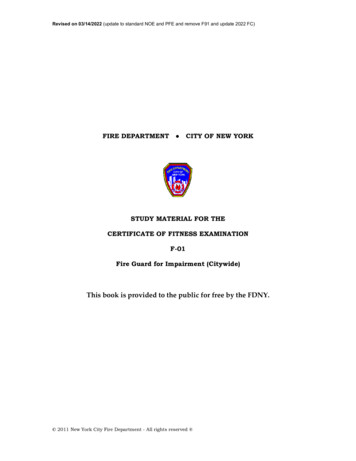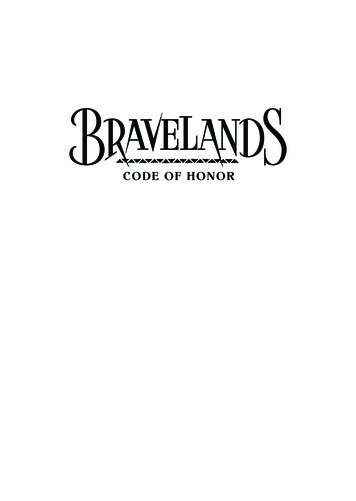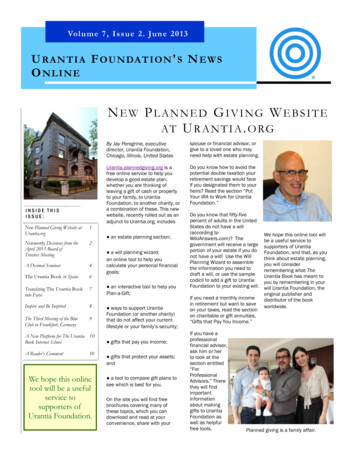
Transcription
Revised on 03/14/2022 (update to standard NOE and PFE and remove F91 and update 2022 FC)FIRE DEPARTMENT CITY OF NEW YORKSTUDY MATERIAL FOR THECERTIFICATE OF FITNESS EXAMINATIONF-01Fire Guard for Impairment (Citywide)This book is provided to the public for free by the FDNY. 2011 New York City Fire Department - All rights reserved
TABLE OF CONTENTEXAM SPECIFIC INFORMATION FOR F-01 CERTIFICATE OF FITNESS 1STUDY MATERIAL AND TEST DESCRIPTION . 4INTRODUCTION . 6PART 1. REQUIREMENTS AND DUTIES . 91.1Orientation . 91.2Fire Guard Patrols. 141.3Inspection Record. 151.4Fire Department Notification and Emergency Procedures . 17Fire Watch/Fire Guard Daily Record (example) .161.4.11.4.21.4.31.4.4Fire Department notification for impairment .17Emergency notification and procedures .17Manual or pull station devices .19Safety requirements .20PART 2. FIRE PROTECTION SYSTEM AND FIRE EXTINGUISHERS . 222.1Sprinkler System. 222.2Standpipe System . 232.3Fire Alarm System . 232.4Portable Fire Extinguishers . 232.4.12.4.22.4.3Typical fire extinguishers .25Portable Fire Extinguisher Tags .26Fire extinguisher inspections .27Appendix A . 29IMPAIRMENT COORDINATOR AND FIRE WATCH REQUIREMENTS ANDHOT WORK RESTRICTIONS FOR OUT OF SERVICE FIRE PROTECTIONSYSTEMS AT CONSTRUCTION SITES . 29This book is provided to the public for free by the FDNY.A
EXAM SPECIFIC INFORMATION FORF-01 CERTIFICATE OF FITNESSSave time and submit application online!Applicants who submitted and paid online for an exam before arriving at theFDNY will not need to wait in line to enter the FDNY.It can take about 30 minutes to complete. Completing application andpaying online will eliminate waiting outside in the long lines.Simplified instructions for online application and payment can be found reate an Account and Log in NYCIDLogin.aspxREQUIREMENTS FOR CERTIFICATE OF FITNESS APPLICATIONGeneral requirements:Review the General Notice of /business/general-notice-of-exam-cof.pdfSpecial requirements for the: F-01 Certificate of Fitness: NoneApplication fee (Cash is NO LONGER ACCEPTED):Pay the 25 application fee online or in person by one of the following methods: Credit card (American Express, Discover, MasterCard, or Visa) Debit card (MasterCard or Visa) In person: Personal or company check or money order (made payable to theNew York City Fire Department)A convenience fee of 2% will be applied to all credit card payments.For fee waivers submit: (Only government employees who will use their COF fortheir work- related responsibilities are eligible for fee waivers.) A letter requesting fee waiver on the Agency’s official letterhead stating applicantfull name, exam type and address of premises; AND Copy of identification card issued by the agencyREQUIREMENTS FOR ALTERNATIVE ISSUANCE PROCEDURE (AIP)No AIP available. This certificate of fitness can only be obtained by passingthe computer exam at the FDNY Headquarters.This book is provided to the public for free by the FDNY.1
EXAM INFORMATIONThe F-01 test will consist of 20 multiple-choice questions, administered on a “touchscreen” computer monitor. It is a time-limit exam. Based on the amount of thequestions, you will have 30 minutes to complete the test. A passing score of at least70% is required in order to secure a Certificate of Fitness.Call (718) 999-1988 for additional information and forms.Please always check for the latest revised booklet at FDNY website before you takethe l important notice: Current F-92 Certificate of Fitness’s are valid and renewable. The F-03, F-04 and F-92 Certificate of Fitness tests are available as a separatetest.Exam site:FDNY Headquarters, 9 MetroTech Center, Brooklyn, NY. Enterthrough the Flatbush Avenue entrance (between MyrtleAvenue and Tech Place).This book is provided to the public for free by the FDNY.2
RENEWAL REQUIREMENTSGeneral renewal requirements:Review the General Notice of /business/general-notice-of-exam-cof.pdfSpecial renewal requirements for F-01 COF: NoneThe FDNY strongly recommends the F-01 COF holders to renew the COF online. To learn the simplified on-line IONS?FDNY Business Support Team: For questions, call 311 and ask for the FDNYCustomer Service Center or send an email to FDNY.BusinessSupport@fdny.nyc.govThis book is provided to the public for free by the FDNY.3
STUDY MATERIAL AND TEST DESCRIPTIONAbout the Study MaterialThis material will help you prepare for the examination for the Certificate of Fitness for fireguard for impairment. The study material includes information taken from the New YorkCity Fire Code. This study material consists of 2 parts. The exam covers the entire bookletand any tables. It will not be provided to you during the test. It is critical that youread and understand this booklet to help increase your chance of passing this exam.The study material does not contain all of the information you need to know to work as afire guard. It is your responsibility to become familiar with all applicable rules andregulations of the City of New York, even if they are not covered in this study material. Inorder to adequately prepare for the exam, you need to be familiar with the 2022 Fire CodeSection 401.3, 408, 901 and 906 and the NFPA 25 Chapter 14 (2002 Ed.) which regulatethe duties of fire guards for performing fire watch when any required fire protection systemis out of service.2022 FIRE CODE ENACTEDThe amended New York City Fire Code, to be known as the 2022 Fire Code, takes effect onApril 15, 2022. It may not have been updated in this study material and the exam willbe mainly based on this booklet, not the 2022 Fire Code. However, as the Certificateof Fitness holder, it is your responsibility to become familiar with the applicablesections of the new 2022 Fire Code.Design and installation provisions.The design and installation provisions of the 2022 Fire Code shall apply to: Facilities established and conditions arising on or after 04/15/2022. Facilities and conditions not lawfully existing prior to 04/15/2022.The facilities and conditions lawfully existing prior to the 04/15/2022 can be continued incompliance with the requirements of the former Fire Code/Fire Rule except as otherwiseprovided in the New Fire Code 102.5.Operational and maintenance provisions.The operational and maintenance provisions of the 2022 Fire Code, including permit andcertification requirements, shall apply to all facilities, operations, conditions, uses andoccupancies, regardless of when they were established or arose.Whenever this code is amended or a rule is promulgated to require a permit or certificatefor a facility, operation, condition, use or occupancy, and no permit or certificate waspreviously required therefor pursuant to this code or the rules, such facility, operation,condition, use or occupancy may be continued without such permit or certificate until04/15/2023, except as may otherwise be provided by such amendment or rule.The 2022 Fire Code can be obtained via the following ode/fire-code.pageThe 2014/2022 New York City Fire Code Cross-Reference Table can be referred to thefollowing pdf/codes/fire-code-cross-reference.pdfThis book is provided to the public for free by the FDNY.4
Sample QuestionsThe following questions represent the “format” of the exam questions,not the content of the real exam.1. Which of the following are allowed to be used/displayed while taking aCertificate of Fitness examination at 9 Metro Tech Center?I. cellular phoneII. Study material bookletIII. Reference material provided by the FDNYIV. Mp3 playerA. III onlyB. I, II, and IIIC. II and IVD. I onlyOnly reference material provided by the FDNY is allowed to be used during Certificateof Fitness examinations. Therefore, the correct answer would be A. You wouldtouch “A” on the computer terminal screen.2. If you do not know the answer to a question while taking an examination,who should you ask for help?A. the person next to youB. the firefightersC. the examiner in the testing roomD. you should not ask about test questions since FDNY staff can not assistapplicantsYou should not ask about examination questions or answers since FDNY staff cannotassist applicants with their tests. Therefore, the correct answer would be D. Youwould touch "D" on the computer terminal screen.3. If the screen on your computer terminal freezes during your examination,who should you ask for help?A. the person next to youB. the firefightersC. the examiner in the testing roomD. the computer help deskIf you have a computer related question, you should ask the examiner in the testingroom. Therefore, the correct answer would be C. You would touch C. You wouldtouch "C" on the computer terminal screen.This book is provided to the public for free by the FDNY.5
INTRODUCTIONThis material outlines New York City Fire Department (FDNY) guidelines for fire guardperforming a fire watch. This happens when a required fire protection system is out-ofservice. Fire guards are required to inspect the areas in which the fire protection systemsare out of service for fires.Responsibility of the Building OwnerThe building owner or their agent shall give an impairment coordinator all the necessarydocuments. That may include records, tests, servicing and other items relating tomaintenance of fire protection systems. Such records shall be kept at work for a period ofthree years and made available for inspection by any member of the FDNY. In absence ofan impairment coordinator the building owner shall act as the impairment coordinator.RequirementsIn any occupancy, where a required fire protection system is out of service, a fire watchshall be maintained. Fire watch can be maintained by one or more persons holding an F-01certificate of fitness for fire guard. The fire guard(s) is/are required to be immediatelyavailable when the system is out-of-service with the following exception:For the initial 4 hours of an unplanned and planned out of service condition when theeffected area does not exceed 50,000 square feet, the impairment coordinator or atrained and knowledgeable person who is capable of performing fire watch duties andis designated by the building owner may perform the duties of the fire watch.The impairment coordinator or a trained and knowledgeable person designated by thebuilding owner must begin conducting a fire watch in the area where the fire protectionsystems are out-of-service. After 4 hours of an out of service condition, such patrols shallonly be conducted by fire guards holding the F-01 certificate of fitness.The number of fire guards depends on the location and the size of the area affected by theout-of-service fire protection system. A fire guard must be available to patrol all areas inwhich the fire protection system is out of service at least once every hour. No individualfire guard must patrol more than 50,000 square feet of building floor area. If coverage areais over 50,000 sq. ft. more than 1 fire guard must be assigned.The recommended coverage for doing the fire watch is summarized in the table below.Planned or UnplannedAreaThe initial 4 hours 4 hours 50,000 ft2 50,000 ft2A F-01 C of F holder oran Impairment coordinator ora trained and knowledgeablepersonOne F-01 C of F holderOne F-01 C of F holder per 50,000 square feetThe fire guard duties must be on a 24 hours a day basis. Duties must continue until thesystems are restored to good working order. In some cases, Fire Department workers maybe on scene to give directions. Such as the number of required fire guards or other fireprotection measures that may be required.Special requirements for construction siteThis book is provided to the public for free by the FDNY.6
The fire watch requirements at construction site will depend on whether the fire protectionsystems have been installed and approved yet. No impairment coordinator or fire watch isrequired before the system is installed and approved. “Installed and approved” means thatall required approvals for a full or partial installation have been obtained, including allsignoffs from the Department of Buildings. The Construction Site Fire Safety Manager mustbe designated to be the impairment coordinator if any installed and approved fireprotection system is out of service. Unless the building is vacant, a fire watch must bemaintained until the system is back to service. The Fire Department has posted guidanceon its website explaining the impairment coordinator, fire watch and hot workrequirements when fire protection systems are out of service on construction sites. Thisguidance is attached as Appendix A.The Certificate of Fitness holder must keep the Certificates of Fitness readilyavailable for inspection by any representative of the Fire Department. This must bedone at all times while conducting or supervising the material, operation or facilityfor which the certificate is required.The fire guard for impairment is recommended to be familiar with the types of fire safetyevacuation plans for the buildings where they provide fire watch. They should also befamiliar with the associated staff available to implement the fire plan. The fire guard mustbe aware of his obligations for notifying the Fire Department in the event of fire (FCChapter 4 Section 401.3). Further information is available at: Emergency Planning and Preparedness: [FC Chapter 4 Section 401.3 and Section408]Fire Protection System: [FC Chapter 9 Section 901 and Section 906]This book is provided to the public for free by the FDNY.7
DEFINITIONSFIRE GUARD: A person holding a Certificate of Fitness for such purposes, who is trainedin and responsible for maintaining a fire watch and performing such fire safety duties asmay be prescribed by the commissioner.FIRE WATCH: A temporary measure intended to ensure continuous and systematicsurveillance of a building or portion thereof by one or more qualified individuals for thepurposes of identifying and controlling fire hazards, detecting early signs of fire, raising analarm for fire, and notifying the department.IMPAIRMENT: Any condition in which a fire protection system cannot perform its designedfire safety function. Fire protection systems include sprinkler systems, standpipe/hosesystems, fire pumps; fire protection water supplies, fire mains, fire alarm systems, andspecial extinguishing systems (i.e. clean agent, carbon dioxide, wet/dry chemical,foam/water, etc.).IMPAIRMENT COORDINATOR: The person designated by the owner and responsible forensuring that proper notification and safety precautions are taken when a fire protectionsystem is out of service.PLANNED OUT OF SERVICE CONDITION: The impairment coordinator shall be madeaware in advance of any planned removal from service of a standpipe system, sprinklersystem or fire alarm system, or system component, for repair, servicing, testing,maintenance, alteration, or to allow construction to be performed in the area protected bythe system without unnecessarily activating it.UNPLANNED OUT OF SERVICE CONDITION: Unplanned out of service conditions areserious defects such as empty tanks, breaks or major leaks in the system water piping,inoperative or shut water supply valves, defective fire department connections, etc. whichrender a standpipe system, sprinkler system or fire alarm system inoperable or otherwisecausing it to no longer be in good working order.This book is provided to the public for free by the FDNY.8
PART 1. REQUIREMENTS AND DUTIESFire guards are required to reduce the threat of fires in a variety of locations. They aretrained in and responsible for maintaining a fire watch. Fire guards must have a generalknowledge of portable fire extinguishers and/or alarm pull stations. If fire guards areresponsible for them; they shall know their locations.An impaired fire protection system presents hazards since detection, notification andextinguishing systems are not working. Individuals and premises cannot depend onimpaired fire protection systems to protect them. Individuals place trust and reliabilityupon fire protection systems, but non-operational systems will not be providing needednotifications or protection.1.1 OrientationThe F-01 Certification of Fitness (C of F) authorizes the individual to act as an impairmentfire guard to maintain fire watch responsibilities. F-01 C of F is valid at any location on acitywide basis. Given this condition, the citywide fire guard for impairment may performtheir duties for different buildings and occupancies.When fire guards arrive to the affected area they should be provided with an orientation.The orientation may come from the fire and life safety director (FLSD), fire safetycoordinator, construction site fire safety manager, building owner, impairmentcoordinator or other on-site personnel. The person providing orientation must befamiliar with and responsible for the buildings fire protection systems.Normally, there is at least 1 fire safety director in a Group B (Office Building) or Group R-1occupancy (Hotel) building (as described in the following table). The fire guard must workclosely with the FLSD (Fire and Life Safety Director).At most construction sites, there will be at least one construction site fire safety manager(or site safety manager or site safety coordinator). The fire guard must work closely withthese fire/site safety manger closely.If there is no FLSD available in the building, the fire guard should speak to the buildingowner or the responsible person designated by the building owner to become familiar withthe specifics of the building.FOR ALL BUILDINGS/OCCUPANCIES: Before starting to patrol the affected area, the fireguard should have enough knowledge to identify:(1) the entry routes to the affected area;(2) the extent of the out-of-service condition;(3) the location of hazardous materials that are stored, handled or used in the building(including fuel oil storage tanks);(4) the location of portable fire extinguishers;(5) the means available for the fire guard to make required notification.The fire guard should pay attention to the affected area where hazardous materials isstored, handled or used. The fire guard shall ensure the hazardous materials are stored,This book is provided to the public for free by the FDNY.9
handled or used only in the chosen areas. Hazardous material shall be stored, handled orused away from any ignition sources.The fire guard should evaluate the risk of the impairment situation. The risk may beaffected by the following:The level of the hazardous materials. Flammable liquids are more dangerous than combustible liquids. Flammable compressed gas (acetylene or propane) are more dangerous than nonflammable compressed gas.The amount of the hazardous material. The maximum quantity of aerosol products in a retail display purpose may be10,000 pounds for the ground level area. It may be as much as 24,000 pounds perfloor in a warehouse.The number of occupant in the affected area. It is more difficult to evacuate 1,000 people at a party than 10 people in awarehouse.The occupants familiarity of the building. The customers in a restaurant may need more assistance in finding the exit thanresidents in their own apartment. The children in day care facilities may need moreassistance in evacuation than adults in a department store.The number of impaired fire protection systems in the building. If a building has both an out of service sprinkler system and fire alarm system, therisk to building occupants is greater than if only one system is impaired.THE HIGHER THE RISK THE IMPAIRMENT SITUATION PRESENTS, THE MOREATTENTION TO BUILDING FAMILIARITY THE FIRE GUARD MUST HAVE.Structure/ DescriptionOccupancyConstruction Building undergoing construction, alteration orSitedemolitionGroup AA-1A-2Assembly: for gathering together peopleWith fixed seating, intended for the productionand viewing of the performance arts or motionpicturesFood and/or drink consumptionA-3Worship, recreation or amusement, and otherassembly uses not classified elsewhere inGroup AA-4Indoor sporting events or activities withspectator seatingParticipation in or viewing outdoor activitiesBusiness: Office, professional, service-typetransaction, public or civic servicesA-5Group BExamplesNew building under construction;buildings or floors undergoingalteration; buildings under demolitionTheaters,Concert hallsBanquet halls, Cafeterias, Bars,RestaurantsArt galleries, Bowling alleysClassrooms (with 75 persons or more)Courtrooms, Houses of worshipMuseums, School auditoriumsSwimming poolsTennis courtsGrandstands, Bleachers, StadiumsBanksCivic administration officesEducational occupancies above the12th grade (not in Group A)Nonproduction LaboratoriesRadio and television stations notadmitting an audienceThis book is provided to the public for free by the FDNY.Hazardousmaterials?Very likelyNot likelyNot likelyNot likelyNot likelyNot likelyNot likelyModeratelylikely10
Structure/ DescriptionOccupancyGroup EEducational: 5 or more persons at any one timefor educational purposes offered to childrenthrough he 12th grade and where no more than2 children under the age of 2Group FFactory: for assembling, disassembling,fabricating, finishing, manufacturing,packaging, repair, cleaning or processingoperation that are not in Group HF-1Moderate-hazardF-2Group HH-1Low-hazard: involve non-combustible, nonflammable materials, or low-hazardousproductionHigh Hazard: for manufacturing, processing,generation or storage of materials thatconstitute a physical or health hazard inquantities in excess of the those found in BCtable 307.7(1) and table 307.7(2)Materials that present a detonation hazardH-2Uses present a deflagration hazard or a hazardfrom accelerated burningH-3Materials that readily support combustion orpresent a physical hazardH-4H-5Materials that are health hazardsSemiconductor fabrication facilities usinghazardous production materials (HPM) inexcess of the permitted aggregate quantityInstitutional: people are cared for or live in asupervised environmentHousing persons, on a 24-hours basis, capableof self-preservation and responding to anemergency situation without physicalassistance from staffMedical, surgical, nursing or custodial care, ona 24-hour basis, of more than 3 persons, whoare not capable of self-preservation orresponding to an emergency situation withoutphysical assistance from staffMore than 5 persons who are detained underrestraint or security reasonGroup atelyDay care facilities where no more than likelytwo children are under the age of 2Very likelyAircraft repairs, BakeriesManufacturing motor vehiclesDry cleaning using or storingcombustible solventsFood processing (except meatslaughtering)Production laboratories (moderatehazards)Appliances, Glass productsProduction laboratories (low hazards)Nonflammable plastic productsVery likelyExplosive MaterialsDenotable water-active materialsFlammable or combustible liquids areused in open systemFlammable gasFlammable or combustible liquids areused in close systemFlammable solidsOxidizing cryogenic fluidCorrosive, Toxic materialsVery likelyVery likelyVery likelyVery likelyVery likelyVery likelyVery likelyNot likelyAlcohol and drug abuse rehabilitationcentersHalfway housesNot likelyHospitals, Nursing homesMetal hospitals where patients are notunder restraintVery likelyMental hospitals where patients areunder restraintPrisons, Jails, Detention centersNot likelyThis book is provided to the public for free by the FDNY.11
Structure/ DescriptionOccupancyI-4Day care facilities, occupied by persons of anyage who receive custodial care (withoutovernight) by individuals other than parents,guardians, or relatives in a place other than atthe home.Group MMercantile: display and sale of merchandiseGroup RR-1R-2R-3Group SS-1S-2Group UResidential: for dwelling or sleeping purposeswhen not classified as Group IOccupied for a period less than one monthMore than 2 dwelling units for shelter andsleeping accommodation on a long-term basisfor a month or moreNo more than 2 dwelling units on a long-termbasis for a month or moreStorage: for storage when not classified as ahazardous occupancyModerate-hazard storage occupancy for anyflammable or combustible materialsLow hazard storage occupancy for noncombustible materialsUtility & Miscellaneous: structures of anaccessory character, or not classified in anyspecific occupancyExamplesDay nurseriesHazardousmaterials?Not likelyDepartment stores, Drug storesMotor fuel-dispensing facilitiesWholesale storesVery likelyHotels, Homeless sheltersSchool student dormitories not in R-2GroupApartment houses, Apartment hotelsStudent apartmentsNot likelyOne- and two-family dwellingsGroup homesNot likelyStorage of Aerosol, Boots and shoes,Woolen clothing, FurnitureLeather, Wax candles, etcStorage of Electrical motors, Foodproducts, Glass, etcCarports, Fences more than 6 feet highTowersThis book is provided to the public for free by the FDNY.Not likelyNot likelyModeratelylikelyVery likelyNot likelyNot likely12
Orientation Checklist (Example)ListMark “x”if yes1. Do you have a working cell phone? 2. Are fire extinguishers provided in my area of responsibility?3. Are fire alarm pull stations provided andoperational in my area of responsibility? 4. Do you know the name and contactinformation of building personnel? (That needs to be notified upon discovery ofbuilding hazards or fire.) 5. Information on the extent of out-of-servicecondition in my area of responsibility.Is the alarm system operational?Is the sprinkler system operational?Is the standpipe system operational?6. Have you been provided the informationregarding the hazardous materials stored onthe premises? The type of buildingoccupancy, the characteristics and number ofthe building occupants? The extent of the fireprotection systems in other building areas?NoteIf no, you must obtain one before starting yourfire watch duty.If yes, where are they located?If no, I must carry one fire extinguisher with me.If yes, where are they located?If no, what procedures will be used to notify thebuilding occupants of a fire?For building related fire safety hazards:Name:Phone number:For fire situations, refer to the fire notificationprocedure below. If no, what areas are out-of-service? If no, obtain such information before startingyour fire watch duty.If no, what areas are out-of-service?If no, what areas are out-of-service?Fire Notification Procedure: Call 911 or the Fire Department dispatcher (according to borough). The dispatchernumber is .Notify the building occupants by .Call the designated people (e.g. fire safety director or building owner). Their phonenumbers are:NamePhone numberThis book is provided to the public for free by the FDNY.13
1.2 Fire Guard PatrolsBuildings and its parts that have out-of-service fire protection system must be constantlychecked. Every area of the building must be checked at least once every hour.The fire guards need to make regular inspections of the assigned area. They shall notbe given any other responsibilities. The fire guard shall inspect for smoke and fire,and if found immediately contact the Fire Department.During the checks of the area, the fire guards must make sure there is no fire. Thisperson must also ensure that egress routes, fire extinguishers, and fire alarm pullstations are available. If any problem is found, the fire guard must report it to buildingowner or the responsible person immediately. The designated person will then make plansto have the defects corrected.The inspections may differ from one location to another. However, the following generalinspection rules apply for all locations.(a) Inspect all exits, stairways, and hallways to determine condition
This book is provided to the public for free by the FDNY. 1 EXAM SPECIFIC INFORMATION FOR F-01 CERTIF










